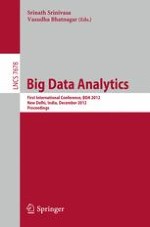This book constitutes the refereed proceedings of the First International Conference on Big Data Analytics, BDA 2012, held in New Delhi, India, in December 2012. The 5 regular papers and 5 short papers presented were carefully reviewed and selected from 42 submissions. The volume also contains two tutorial papers in the section perspectives on big data analytics. The regular contributions are organized in topical sections on: data analytics applications; knowledge discovery through information extraction; and data models in analytics.
